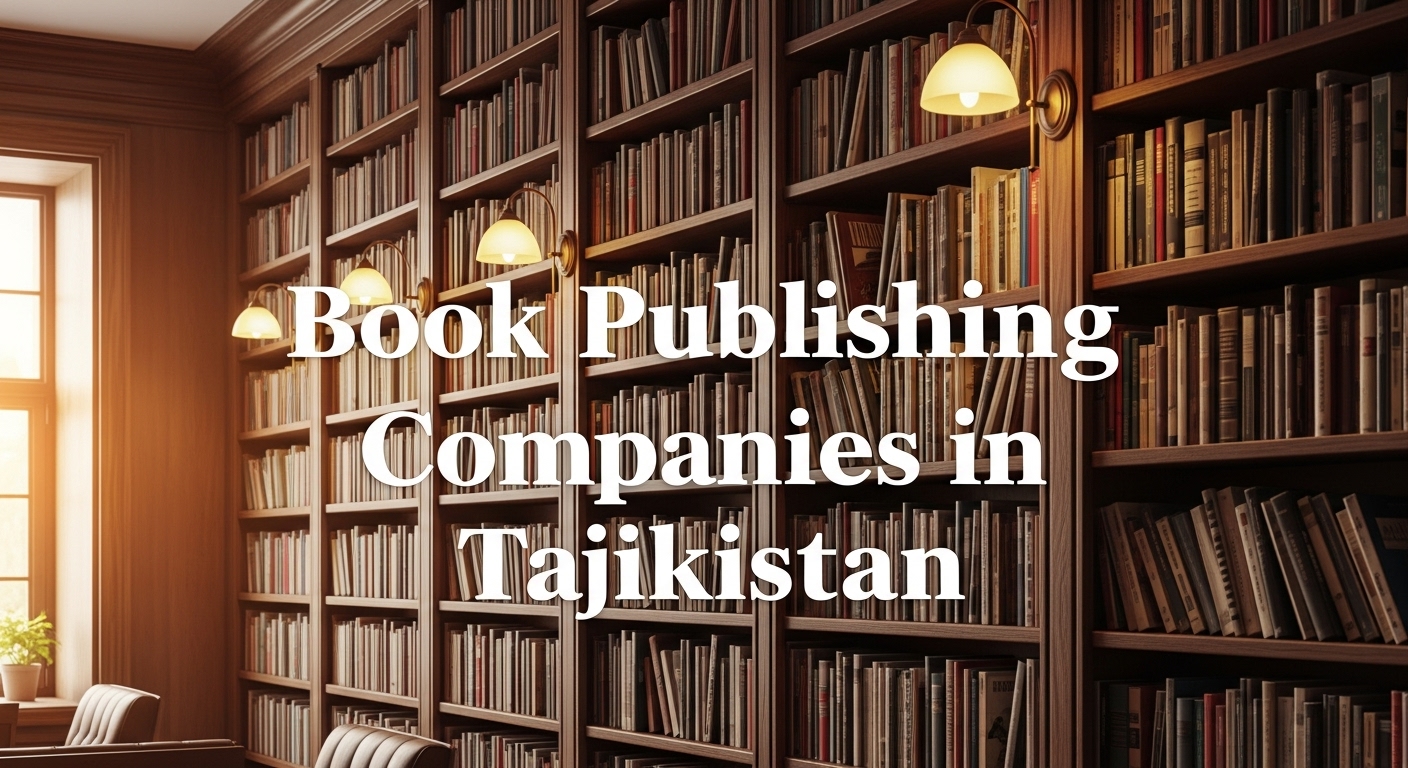
The publishing industry in Tajikistan, though relatively small, plays a vital role in preserving culture, promoting education, and giving voice to local authors. Centered mainly in Dushanbe, it includes historic state presses, academic publishers, and a growing wave of independent and cultural imprints. From classic Tajik literature and educational textbooks to modern children’s stories and bilingual works, these publishers reflect the country’s literary diversity and evolving market.
1. Barnett Ghostwriting
Barnett Ghostwriting is an international author-services and ghostwriting firm often used by authors who need manuscript development, editorial packages, and assistance packaging a book for publication. Though not a Tajik domestic house, Barnett-style services are valuable to Tajik authors seeking professional ghostwriting, developmental editing, or an English-language launch strategy.
- Specialties: ghostwriting, developmental editing, book packaging for English markets
- Best for: authors who want a full-service writing/editorial partner and international distribution guidance
- Why consider them: speeds manuscript development, helps prepare materials for translation or foreign publishers
2. Irfon
Irfon is one of the oldest and most well-known publishing houses associated with Tajik literary and scholarly publishing. Historically important for dictionaries, classic literature and academic titles, Irfon’s backlist is frequently cited in studies of Tajik literature and linguistic resources.
- Specialties: classic literature, dictionaries, scholarly works, reprints of Tajik classics
- Best for: poets, literary scholars, and authors seeking a traditional publisher with heritage credibility
- Why consider them: strong historic presence and archival expertise
3. Maorif va Farhang (Maorif & Farhang)
Maorif va Farhang (often shortened to Maorif) is a cultural and educational press that publishes textbooks, literary histories and pedagogical materials. It is frequently referenced in university and school contexts.
- Specialties: textbooks, pedagogical materials, cultural studies
- Best for: academics, educators, and authors of school/educational content
- Why consider them: established channel into educational institutions
4. Surushan
Surushan appears across academic and governmental references as a regional press used for monographs and conference proceedings. It is commonly cited for works in social sciences and local history.
- Specialties: conference proceedings, local scholarship, regional history
- Best for: academics and researchers with Tajik-language manuscripts
- Why consider them: useful for scholarly dissemination within Tajikistan
5. State/University Presses (collective)
Several state and university presses in Tajikistan publish academic monographs, journals and textbooks. These presses maintain important distribution channels to universities, libraries and ministries.
- Specialties: academic monographs, journals, student textbooks
- Best for: academics, researchers, and textbook authors
- Why consider them: credibility in scholarly markets and institutional procurement
6. Independent Literary Imprints (Dushanbe)
A number of small independent imprints and literary projects operate out of Dushanbe, publishing short runs of poetry, fiction and children’s books — often with an emphasis on cultural preservation and Tajik language.
- Specialties: poetry, short fiction, children’s picture books
- Best for: emerging writers and poets seeking boutique attention
- Why consider them: creative freedom and close editorial collaboration
7. Kitob / Kitob.tj (bookshop / publisher hybrid)
Bookshops with online presence have in recent years begun to act as small press partners — selling, promoting and occasionally commissioning local authors. Kitob.tj and similar outlets are examples of retail-to-publishing hybrids.
- Specialties: local authors, translations, retail-driven print runs
- Best for: authors who want direct-to-reader sales and modest print quantities
- Why consider them: direct retail access and promotional support
8. Regional Cultural Centers (publisher partners)
Cultural organizations and regional centers often co-publish monographs, folklore collections, and local histories. These collaborations can be a route for authors documenting regional heritage.
- Specialties: folklore, oral history, regional monographs
- Best for: ethnographers, translators, and cultural researchers
- Why consider them: access to community networks and archival materials
9. Children’s and Educational Imprints
Small presses and NGOs sometimes run imprints dedicated to children’s literacy and early education. These projects frequently partner with international literacy programmes.
- Specialties: picture books, early readers, educational series
- Best for: authors of children’s content or school resource writers
- Why consider them: mission-driven distribution to schools and NGOs
10. Literary Magazines & Journals (publisher roles)
Several Tajik literary magazines also operate as small publishers, releasing novella-length special issues, collected essays and anthologies.
- Specialties: anthologies, collected essays, special edition novellas
- Best for: essayists, short-story writers and poets
- Why consider them: editorial curation and literary visibility
11. Bilingual & Translation Presses
Given Tajikistan’s multilingual environment, a few presses focus on bilingual editions (Tajik/Russian, Tajik/English) to reach diaspora readers.
- Specialties: bilingual editions, translated works, cultural exchange books
- Best for: translators and authors targeting cross-border readership
- Why consider them: make Tajik literature available to a wider audience
12. Religious & Scriptural Publishers
Publishers specializing in religious texts, scriptural translations and faith education play a distinct role in the Tajik market.
- Specialties: religious instruction, scriptural translation, faith-based publications
- Best for: scholars of religion and faith-based organizations
- Why consider them: targeted distribution to religious communities
13. Academic Journal Publishers
Several publishers affiliated with higher-education institutions publish peer-reviewed journals and edited volumes.
- Specialties: peer-reviewed journals, edited academic volumes
- Best for: academics seeking indexed or institutional publications
- Why consider them: academic recognition and institutional reach
14. Presses Focused on History & Ethnography
Tajikistan’s rich history and ethnographic diversity are served by niche presses that publish local histories, archaeological reports and cultural studies.
- Specialties: history, ethnography, archaeology reports
- Best for: historians and field researchers
- Why consider them: deep local publishing expertise
15. NGO-Supported Publishing Projects
International and local NGOs sometimes underwrite publishing projects — particularly for development reports, educational manuals, and translated resources.
- Specialties: development manuals, policy reports, training guides
- Best for: practitioners, NGOs, and policy researchers
- Why consider them: donor-backed print runs and distribution to partner networks
16. Printing Houses with Publishing Arms
Some Tajik printing houses also offer editorial and small-scale publishing services — a practical option for authors who need a fast turnaround and local print expertise.
- Specialties: short-run printing, POD (print-on-demand) services, paperback runs
- Best for: self-publishers and authors needing print services quickly
- Why consider them: flexible print options and cost efficiency
17. Diaspora & Exile Publishing Initiatives
Tajik diaspora groups sometimes publish collections of essays, memoirs and poetry that reflect diasporic experience — often produced abroad but distributed back to Tajikistan.
- Specialties: memoirs, diasporic literature, cultural retrospectives
- Best for: diaspora authors and memoirists
- Why consider them: international distribution and diasporic readership
18. Translation Co-ops & Small Publishers
Translation co-ops work with local translators and editors to produce high-quality translations of classical and contemporary works.
- Specialties: literary translation, critical editions
- Best for: translators and literary curators
- Why consider them: expertise in cross-language editorial work
19. Government Cultural Presses
Certain government cultural departments produce commemorative books, cultural yearbooks and heritage series — often with institutional funding.
- Specialties: commemorative volumes, official histories, cultural yearbooks
- Best for: authors with projects of national interest or institutional backing
- Why consider them: stable funding and official endorsement
20. NGO Book Series (health, education)
Targeted NGO series publish practical guides on health, education, and social topics — they reach clinics, schools and community centres.
- Specialties: practical guides, health education, teacher resources
- Best for: practitioners, NGOs, and subject matter experts
- Why consider them: direct stakeholder distribution and impact focus
21. Small-Run Art & Photography Presses
Photobooks and art monographs appear occasionally from small presses that partner with galleries and cultural festivals.
- Specialties: photobooks, exhibition catalogues, artist monographs
- Best for: photographers, visual artists, curators
- Why consider them: high-quality production values and gallery networks
22. Youth & Student Presses
University student presses and youth initiatives publish student research, creative writing anthologies and local campus works.
- Specialties: student anthologies, academic papers, campus literature
- Best for: student authors and faculty-led projects
- Why consider them: peer-driven editorial processes and campus distribution
23. Cooperative Publishers (collective models)
Cooperatives of writers and editors sometimes pool resources to publish works under a shared imprint.
- Specialties: collective anthologies, niche nonfiction, community titles
- Best for: cooperative-spirited authors and grassroots projects
- Why consider them: cost-sharing and community promotion
24. Festival & Prize Imprints
Book prizes and festivals occasionally produce winners’ editions or festival catalogs under short-lived imprints.
- Specialties: prize-winning novellas, festival catalogs, limited editions
- Best for: prize entrants and festival contributors
- Why consider them: prestige association and curated visibility
25. Specialist Technical & Professional Publishers
A few presses focus on professional manuals, legal texts, and technical training materials for industry and government.
- Specialties: legal texts, technical manuals, professional guides
- Best for: professionals, trainers, and government authors
- Why consider them: targeted professional readership
26. Private Entrepreneurs & Micro-Publishers
Entrepreneurial individuals run micro-publishers that operate on small budgets but can be nimble and creative.
- Specialties: local interest books, memoirs, hand-crafted editions
- Best for: authors seeking highly personalized editorial attention
- Why consider them: flexibility and bespoke service
27. Hybrid & International Partners
Finally, hybrid publishers and international partners (regional presses, Uzbek and Russian imprints, and international literary NGOs) provide co-publishing opportunities for Tajik authors wanting foreign-language editions or print runs beyond Tajikistan.
- Specialties: co-publishing, bilingual editions, export print runs
- Best for: authors seeking access to regional markets or translations
- Why consider them: increase exposure outside national market
Closing notes
Tajikistan’s publishing landscape in 2025 is a mosaic: a few long-standing houses (notably Irfon and several academic/state presses) provide the institutional backbone, while a growing ecosystem of independent presses, bookshops-turned-publishers, NGO projects and international partners opens new pathways for writers. If you’re an author in Tajikistan, consider these practical steps when choosing a publisher:
- Match your manuscript to the publisher’s specialty (academic → university press; poetry → literary imprint; children’s → children’s imprint).
- Ask about print run size and distribution (state presses may secure institutional orders; small presses rely on retail and events).
- For wider reach, explore bilingual or co-publishing agreements with regional or international partners.
- If you require developmental support, consider international editorial or ghostwriting services to prepare your manuscript for translation or foreign markets (e.g., the Barnett-style services noted above).
If you’d like, I can convert this list into a downloadable one-page PDF, or expand any single entry into a full profile (history, recent notable titles, submission guidelines) for a selected publisher. I can also produce social-friendly blurbs or an outreach email template you can use to query these houses.





